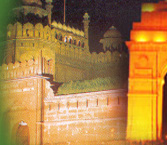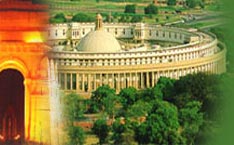The North and South block are the two blocks of that form the secretariat building. These buildings are situated at Raisina Hills, and flank the Rashtrapati Bhavan, the residence of the Indian President. These two buildings house the most important offices of the government of India, including the Prime Minister�s office. The entire area is one of the major tourist attractions in New Delhi, and tourists from all over the world come here during their New Delhi tours. The grandeur and significance of these buildings make them important part of tourism in New Delhi.
The North and South block face each other on opposite sides of Rajpath, the stretch of road leading up to the Rashtrapati Bhavan. The buildings were designed by Herbert Baker, an eminent British architect in those days. He used Mughul and Rajasthani architectural forms and fused them carefully and ingeniously with European forms. The result is a unique structure that gives this important complex a distinctive look. Red sandstone, the traditional building element used in most Mughul buildings, has been used to build the North and South block as well. Domes, latticed screens, arched gateways, and pillared corridors can be found in both these buildings, as in the presidential residence, all typical features found in the Mughul buildings.
The plinth of the buildings rises to 30 feet above ground. Construction was completed in 1929. The total cost of construction along with that of the Rashtrapati Bhavan was 17.5 million Rupees. Both the blocks have four floors each, and contain about a thousand rooms in total. The interior of the two blocks are adorned by beautiful fountain courts and pillared passages. The two buildings also contain several paintings and sculptures making them aesthetically pleasant structures. Two sandstone columns face each block. These are surmounted by a bronze ship, and symbolize the four great erstwhile colonies of England, namely, South Africa, Canada, Australia, and New Zealand.
The North and South blocks house some of the most important offices in the entire country. The South Block can be called the more important of the two, as it contains the prime Minister�s office, popularly known as the PMO. The other important offices located in South Block include the offices of the Ministry of Defense and Ministry of External Affairs. As the Prime Minister is the most important person in Indian governance, the South Block can be called the center of political power in India.
The North Block, facing the South Block on the other side of the Rajpath, contains the offices of the ministry of Finance and the Home ministry along with other important offices.
The two blocks are floodlit during the national festivals, and present a spectacular sight for the passers by. The area between the two blocks is known as Vijay Chowk (victory square). It is the venue of the beating of the retreat ceremony held on the 29th of January every year.
Some of the most important landmarks of New Delhi are located near the North and south blocks. These include the Rashtrapati Bhavan, the Parliament House, India gate, and the Jantar Mantar. Prior permission from the concerned authorities is required to visit these buildings.
Touristplacesinindia.com offers online information about North and South block in New Delhi, and other tourist places in India.
 |
| 


